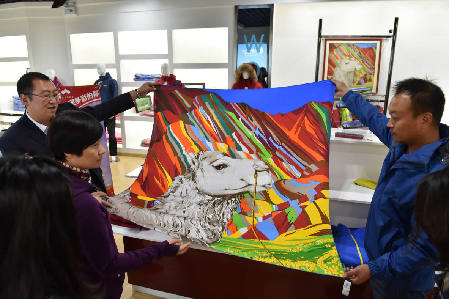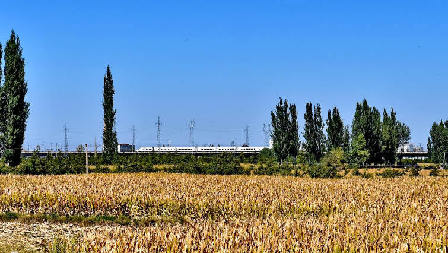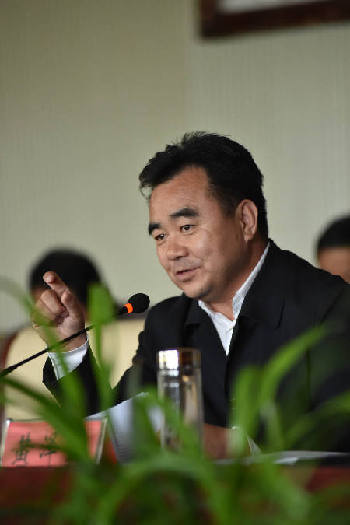ZHANGYE, known as Ganzhou in ancient times and reputed as “Golden Zhangye” today, is located in northwest China’s Gansu Province. It is the largest oasis in the middle section of the Hexi Corridor and was once the sole path to the ancient Silk Road. Over two millennia, monks, travelers, and merchants of various ethnicities from East and West converged here. The city was thus instrumental in promoting Eastern and Western cultural exchanges and integrating different ethnic groups. Today, Zhangye is home to 38 ethnic groups – more than half of the total in China. People of various religions and belief systems coexist harmoniously here amid suitably diverse styles of architecture, so forming a unique environment of commingling multi-culture.
Under the auspices of the Chinese government’s Belt and Road Initiative, the Zhangye municipal government plans to make the city an ecological safe shelter zone, a regional transportation hub, a green and organic agricultural products base, and an international tourist destination along the Silk Road. Huang Zeyuan, mayor of Zhangye City, intends to ensure that Zhangye makes full use of its geographical advantages and multi-cultural environment by adopting an inclusive attitude to better development in a new historical era. Huang, who majored in history, has extensive knowledge of the city’s past. He gave the China Today reporter an introduction to Zhangye’s long history and rich culture, and also expounded on its current opportunities and plans for the future.
|
|
|
The Lanzhou-Urumqi Railway has made Zhangye an important city along the Silk Road Economic |
Regional Transportation Hub
“The Silk Road is a trade route well-trodden by pioneers between East and West. Through various businesses conducted along it, the road evolved into a medium for cultural transmission and the fusion of different ethnic groups. Zhangye was at the intersection of the northern, central and southern routes of the ancient Silk Road,” Huang Zeyuan said, clearly and justifiably gratified at Zhangye’s geographical location.
“Zhangye has the Qilian Mountains to its south, and acts as border between the Qinghai-Tibet Plateau and the Loess Plateau. Four oases have formed out of the runoff from the Qilian Mountains. Their headwaters are all located in Zhangye. The Heihe (Black River), China’s second longest inland river, runs through and nourishes Zhangye, keeping it fertile. Nature’s bounty has resulted in abundant production and thriving businesses in Zhangye. From the Han (207 BC - AD 220) to the Tang Dynasty (618-907), Zhangye was the largest trading center second only to the ancient capital of Chang’an, today’s Xi’an. It was also a key stop along the Silk Road for merchants to trade and replenish their wares. During the Yuan Dynasty (1271-1368), Zhangye was designated the capital city of Gansu Province, and construction site of the country’s biggest granary for army rations. By the Ming (1368-1644) and Qing (1644-1911) dynasties, scores of guild halls that had been established in Ganzhou served merchants from all regions. Zhangye’s business culture was hence a key component of the culture of the Silk Road,” Huang said.
As a main stop for replenishing supplies along the Silk Road, Zhangye accommodated officials, envoys, businessmen, and eminent monks such as Faxian (334-420) during the Eastern Jin Dynasty (317-420), and Xuanzang (602-664) – main character in Wu Cheng’en’s classic novel Journey to the West – during the Tang Dynasty.
“In 1275, when he was just 19 years old, the Venetian merchant traveller Marco Polo visited Zhangye. The Chronicle of Events in Zhangye records that in the summer of 1274, Marco Polo accompanied his uncle to the court of Kublai Khan, Emperor Shizu of Yuan, somewhere near today’s Xilin Gol Grassland in Inner Mongolia Autonomous Region, where he reported on the completion of a task. As the route was impassable, he stayed in Ganzhou for almost a year. Marco Polo Street – a European style thoroughfare built in 2003 – now stands in Zhangye. Walking along it, visitors can get a sense of the history and culture of the city, and appreciate its openness and prosperity in former times,” Huang said.
When talking about today’s Silk Road Economic Belt, Huang explained that in addition to its function of cultural transmission, the belt is also an important medium for economic transactions. Zhangye is a key location along it. “Underground is a pipeline for transporting natural gas from west to east. We also have an oil pipeline. Above ground we have a railway and a highway to transport coal to the east, and overhead is an extra-high voltage cable to transfer electricity in the same direction. Zhangye also serves as a pathway for tourists traveling between the west and the east. Moreover, thanks to good natural conditions, Zhangye is an ideal location for organic farming. Its organic products are exported to regions in Central Asia and Europe, and are also in popular demand among local customers,” Huang said.
|
|
|
Huang Zeyuan, mayor of Zhangye City. |
Commingled Cultures
Zhangye has a long history and rich culture. “As early as 111 BC, Zhangye was established as a prefecture under the jurisdiction of the central government. A nexus of religious integration among various eastern and western cultures, Zhangye has earned its reputation as a famous historical and cultural city in China,” Huang said.
Zhangye was originally composed of settlements inhabited by ethnic minorities. In earlier times it was the sole route from the Western Regions to the Central Plains, and consequently a strategic location. In the past, several ethnic groups, including the Rouzhi ethnic group, the Xiongnu (Huns), the nomadic Rouran, various Turkic peoples, the Tangut and Tubo peoples, and the Mongols, settled in Zhangye. Among them the Xiongnu, Tangut and Mongols either established their own regimes or exercised effective jurisdiction. Today, people from 38 ethnic groups live in Zhangye, among them the Yugur, who live exclusively in China.
Zhangye was an important node of Buddhism on the Silk Road from West to East. Eminent monks Faxian and Xuanzang, respectively, passed through Zhangye and expounded on Buddhist texts here, leaving a legacy of precious cultural relics and legends. The Giant Buddha Temple in Zhangye was once the national temple of the Western Xia Dynasty (1038-1227). Built in 1098, the main hall is well preserved, its style and features unchanged, which is rare in China. Zhangye has also witnessed harmonious coexistence of various religions. Historical texts described the scenery in Zhangye as “a reedy landscape dotted with pagodas.” The Travels of Marco Polo includes a detailed account of the religions and different architectural styles of their places of worship in Zhangye, evident in churches, temples and mosques. By the Qing Dynasty, religions practiced in Ganzhou included Buddhism, Daosim, Islamism, and Zoroastrianism.
Huang believes that people of different cultures should appreciate and learn from one another. “There are Tibetan Buddhist temples, Han-Chinese Buddhist temples, and mosques in Zhangye. Daoism and Confucianism coexist here, forming a multi-cultural environment. This makes the city more inclusive of different cultures and so of greater appeal to visitors from other parts of the world,” Huang said.
 |
|
Locally produced scarves featuring the Danxia landform pattern are part of the campaign to disseminate Zhangye culture through clothing and accessories. |
Develop Green Industry
Owing to Zhangye’s distinctive geographical location its ecological security is of particular significance. “Any ecological deterioration in Zhangye would affect the Qinghai-Tibet Plateau to its south and expand southward the Inner Mongolian desert to its north. Its high altitude and droughts in landlocked areas render Zhangye’s ecological environment extremely weak. As one of the most important ecological security belts in China, therefore, Zhangye must adopt eco-friendly economic development as a matter of urgency,” Huang said. “We need to balance environmental protection and economic development. We also plan to develop tourism and cultural industry and make full use of our abundant agricultural resources to develop eco-friendly agriculture and circular economy. On top of that, we would like to develop eco-industry at a moderate pace,” Huang said.
Huang expounded his standpoint on tourism development in Zhangye. “Any scenic spot can be attractive if it has a cultural background. More and more tourists come to the Hexi Corridor because the Silk Road Economic Belt has polarized interest in the ancient Silk Road. We want to make culture the soul of tourism development in Zhangye. The city’s rich and colorful multiculture will attract more visitors, and through spending time in Zhangye visitors get to know the city through its history,” Huang said.
Huang also observed that people are no longer content simply to visit scenic spots. They also enjoy interactive experience, so outdoor activities are the best choice. It is far more fun to ski snow-capped mountains and travel off-road deserts rather than just look at them. Anyone – hiker, driver, swimmer, or river floater – can enjoy their favorite outdoor pursuits in Zhangye.
Zhangye is a transitional area between the Qinghai-Tibet Plateau and the Inner Mongolian Plateau. Other than an ocean, it has almost all natural topographical features, including glaciers, snow-capped mountains, forests, grasslands, rivers, lakes, deserts, oases, wetlands, and Danxia landforms. Some are particularly impressive. For example, Chinese netizens have voted the Zhangye Danxia Landform Geopark, with its colorful rock formations, one of the 22 most impressive scenic spots in the world. Diverse terrains and landforms provide natural conditions for all kinds of outdoor adventures. According to Huang, half a million tourists visited Zhangye in the year 2000. The number jumped to 1.1 million in 2009 and soared to more than 10 million in 2014. “The number of tourists doubled in the decade from 2000 to 2009, and grew almost ten-fold in the following five years. Taking into account its bountiful natural tourist resources and our efforts to improve our management and services, we are confident we can build Zhangye into an international tourist destination,” Huang said.
When talking about agriculture, a traditional national strength, Huang said that Zhangye contributes half of China’s corn seed production. Resources such as sunshine, water, and land are sufficient, and in their best combination in Zhangye. The local government plans to make the city a green and organic farming center, its focus on producing corn seed, high quality vegetables, fruits, and mushrooms, as well as raising beef. By strictly observing national food security standards and promoting a model of organic and safe food production, the government plans to build a complete industrial chain of crop production, breeding industry, and mushroom growing and food processing industry, so fostering a batch of leading enterprises with competitive products. The aim is to make Zhangye the most important organic agricultural production center along the Silk Road Economic Belt.



